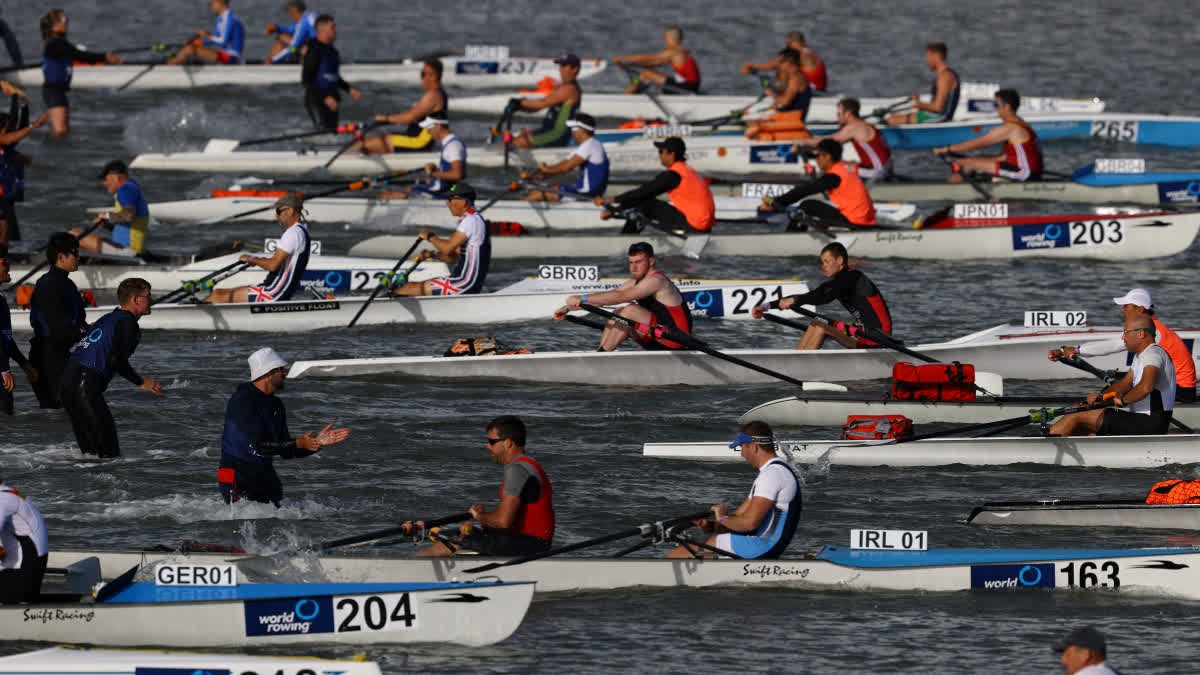With the clock ticking every second, the kick-off date of the much anticipated Paris 2024 Olympics is approaching, and the buzz among sports enthusiasts is achieving new highs daily. The Indian contingent will compete with over 100 athletes representing the nation. Many sports have multiple entries but some will feature only one athlete from the country and rowing is one such event.
India is sending their highest-ever contingent for the upcoming Paris Olympics 2024. Following their record (seven medals) outing in the Tokyo Olympics, the expectations for breaching the double-digit medals tally will be sky-high. Let's delve into the sport's history, rules, India's contingent and it's track-record in rowing at Olympics.
Rowing History At Olympics:
Rowing was the medium of transportation in ancient Egypt, Greece and Rome. It became a sport in the late 17th and early 18th centuries in England. It is the sport which has been a part of the Summer Games since the inception of the modern Olympics in Athens in 1896 (men’s events). In that period, the competition was held at sea, but due to bad weather, the event was cancelled. Male rowers have competed since the 1900 Summer Olympics; it witnessed the participation of women in the 1976 Montreal Olympics.
The United States is the most successful nation with 89 medals in the sports at Carnival of Sports which consists of 33 gold, 32 silvers, and 24 bronze. The list is followed by East Germany with 33 gold, seven silvers, and eight bronze and Great Britain with 31 gold, 25 silvers, and 14 bronze. India is yet to win the middle in the sport at the event.
Six-time Olympians Sir Steve Redgrave (five golds, one bronze) and Elisabeta Oleniuc-Lipă (five golds, two silvers, one bronze) are widely hailed as the greatest Olympic male and female rowers of all time.
India In Rowing At Olympics
India’s first-ever participation was marked in the 2000 Sydney Olympics when Kasam Khan and Inderpal Singh secured their place in the Men’s Coxless Pairs. Since the Sydney Games, the Indian contingent has participated in every edition but failed to win a medal for the country. Arvind Singh and Arjun Lal Jat pair finished in 11th place in the Light Weight Men's Double Sculls event of the 2020 Tokyo Olympics. Balraj Panwar, who is the only Indian athlete to compete in the sport at the Paris Games, has the great opportunity to create history, winning a medal for the country in rowing.
PK Paulose( Men's Single Sculls - Placed 27th), Bajrang Lal Takhar (Men's Single Sculls - Placed 21st), Manjeet Singh, Devender Singh Khandwal (Light Weight Men's Double Sculls - Placed 18th), Sawaran Singh Virk (Men's Single Sculls - Placed 16th), Manjeet Singh, Sandeep Kumar (Light Weight Men's Double Sculls - Placed 19th), Dattu Baban Bhokanal (Men's Single Sculls - Placed 13th, Winning Final C) are the few names which have represented India in the sport at Olympics.
India’s Contingent At Paris Olympics
- Balraj Panwar
Balraj Panwar made the cut after finishing third in the men’s single scull event of the 2024 World Asian and Oceanian Olympic Qualification Regatta in Chungju, South Korea. With this victory, he became the only Indian to qualify for the 2024 Paris Olympics in rowing after clocking 7:01.27 minutes to finish third in the 2000 m race and seal the quota.
The 25-year-old Indian Army rower nearly missed out on winning a bronze medal in his Asian Games debut in Hangzhou, China, last year.
Basics of the Games
Rowing has different classes depending on the number of people participating and the type of boat being used. The discipline has 22 boat classes, but the Olympics conduct competitions in only 14 events, seven for men and seven for women, including Single Sculls, Double Sculls, Quadruple Sculls, Coxless pair, Coxless four, and Eight.
The main events held at the Olympics include:
- Single Scull: One athlete in a “scull” boat with two oars (one in each hand)
- Double Scull: Two athletes in a “scull” boat with two oars each (one in each hand)
- Quadruple Scull: Four athletes in a “scull” boat – all with two oars each (one in each hand)
- Coxless Pairs: Two athletes in a boat that has no “coxswain” (a person who sits in the stern to facilitate steering); Each athlete has one sweep oar each
- Coxed Pairs: Two athletes in a boat that has a coxswain present. Both athletes have one sweep oar each
- Coxless Fours: Like Coxless Pairs, only with four athletes instead of two
- Coxed Fours: Like Coxed Pairs, only with four athletes instead of two
- Eights: Eight rowers who all have one sweep oar each with the boat steered by a coxswain
Basic Rules
- The objective of rowing is to reach the finish line first with a boat. The athletes and teams must advance through a series of heats' ' and finish in top three in the final to clinch a medal.
- Rowers compete across a distance of 2,000 meters, alone or in teams of 2, 4 or 8.
- There are two different disciplines: double scull and sweep rowing.
- In sweep events, rowers hold a single oar with both hands, while in sculling they hold one oar in each hand.
- There are six separate lanes in an Olympic event, with one lane assigned to each boat. Athletes and teams are allowed to move across the lanes, provided they do not impede or obstruct another boat whilst doing so.
- Boats must not leave the starting line before firing the gun goes off. Athletes/teams are allowed one “false” start, and will be disqualified if they do it twice.
Read More



